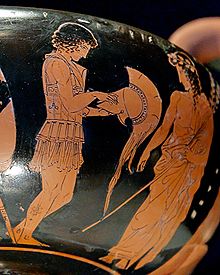

The Eretria Painter was an ancient Greek Attic red-figure vase painter. He worked in the final quarter of the 5th century BC. The Eretria Painter is assumed to have been a contemporary of the Shuvalov Painter; he is considered[ by whom? ] one of the most interesting painters of his time. Many of his best works are painted on oinochoai and belly lekythoi . His paintings often depict many figures, moving in groups across all available surfaces. He also painted such vessels as figure-shaped vases or head-shaped kantharoi . Even as the vase shapes he painted on are unusual, his themes are conventional: athletes, satyrs and maenads, and mythological scenes. There are also some careful studies of women. He also painted white-ground vases. A lekythos in New York shows a funeral scene, typical of white-ground painting: Achilles is mourning Patroclus; the nereids bring him new weapons. The Eretria Painter's drawing style influenced later artists, e.g. the Meidias Painter and his school.